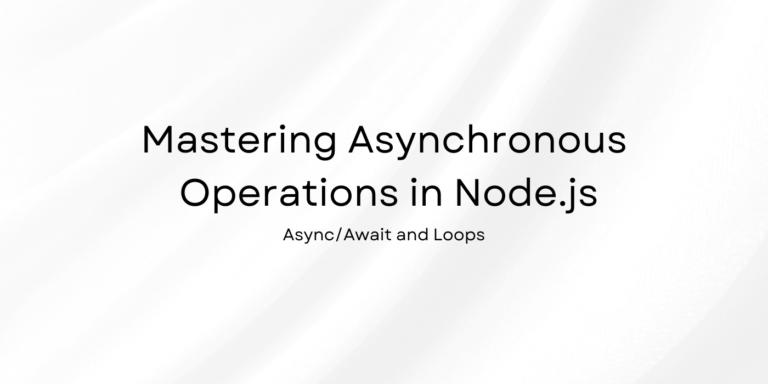Mastering Mongoose Schema Methods and Statics: A Beginner-Friendly Guide

Overview of Mongoose
Mongoose is a popular Object Data Modeling (ODM) library for MongoDB and Node.js. It helps developers structure their data by defining schemas that act as a blueprint for documents in a MongoDB collection.
In Mongoose, schemas not only define the shape of your documents but also provide powerful methods to manipulate data. Two important features of schemas are instance methods and static methods, both of which offer different ways to interact with MongoDB data.
explore complete mongoose schema details
Table of Contents
Understanding Schema Methods
What are Schema Methods?
Schema methods in Mongoose are instance methods that allow you to define custom functions directly on the documents created from a schema. These methods are tied to individual instances (documents) of a model, which means you can call them on a specific record in your database.
In simple terms, schema methods help you define functions that work on specific data documents, making it easier to manipulate or process the data before saving or retrieving it.
Use Cases for Schema Methods
Schema methods are useful when you need to perform operations on individual records. For example, if you need to format user data, perform calculations, or validate specific fields within a document, schema methods are the go-to solution.
Some common use cases include:
- Formatting data before sending it to the client.
- Verifying or modifying values within a document.
- Handling instance-specific logic.
Defining Schema Methods
Schema methods are defined directly within the schema itself. Once defined, you can call them on any document created from that schema. Let’s walk through the steps of how to create and use schema methods.
Step-by-Step Guide: Defining Instance Methods in a Schema
- Define a Schema: Start by defining a Mongoose schema. This schema will represent the structure of your documents.
- Add Methods: You can add instance methods by attaching functions to the schema’s methods object.
- Use the Method: Once you have created a document from the schema, you can call the method on that document.
Example: Defining and Using a Schema Method
Let’s define a method that formats a user’s full name:
const mongoose = require('mongoose');
// Step 1: Define the schema
const userSchema = new mongoose.Schema({
firstName: { type: String, required: true },
lastName: { type: String, required: true },
email: { type: String, required: true }
});
// Step 2: Define an instance method
userSchema.methods.getFullName = function() {
return `${this.firstName} ${this.lastName}`;
};
// Step 3: Create a model from the schema
const User = mongoose.model('User', userSchema);
// Step 4: Use the schema method
const user = new User({
firstName: 'John',
lastName: 'Doe',
email: 'john.doe@example.com'
});
console.log(user.getFullName()); // Output: John DoeExplanation:
- In this example, we defined a getFullName method on the userSchema.
- The getFullName method can be called on any instance of the User model to return the full name of the user.
Practical Examples: Real-World Use Cases for Schema Methods
Example 1: Verifying a User’s Password
Let’s say you’re building a user authentication system. You can create an instance method to verify the password entered by the user against the hashed password stored in the database.
const bcrypt = require('bcrypt');
// Define a method to check the password
userSchema.methods.checkPassword = function(password) {
return bcrypt.compareSync(password, this.password);
};
// Usage
const user = new User({
firstName: 'John',
lastName: 'Doe',
email: 'john.doe@example.com',
password: bcrypt.hashSync('supersecretpassword', 10) // hashed password
});
console.log(user.checkPassword('wrongpassword')); // Output: false
console.log(user.checkPassword('supersecretpassword')); // Output: trueExplanation:
- The checkPassword method compares the provided password with the hashed password stored in the document.
- This makes authentication simple and reusable in your application.
Example 2: Updating Timestamps
Another common use case is automatically updating timestamps whenever a certain field in a document is modified. For example, let’s update the updatedAt field whenever the user’s email is changed.
userSchema.methods.updateEmail = function(newEmail) {
this.email = newEmail;
this.updatedAt = Date.now(); // Update the timestamp
return this.save(); // Save the document with the new email
};
// Usage
const user = new User({
firstName: 'John',
lastName: 'Doe',
email: 'john.doe@example.com'
});
user.updateEmail('new.email@example.com')
.then(updatedUser => console.log(updatedUser))
.catch(err => console.log(err));Explanation:
- We defined an updateEmail method that changes the email and updates the updatedAt timestamp.
- This method saves the updated document, ensuring changes are reflected in the database.
Exploring Static Methods
What are Static Methods?
In Mongoose, static methods are functions that you define directly on the model itself rather than on individual instances (documents). This means that static methods are called on the model and not on a specific document. They are useful when you want to perform operations on an entire collection of documents, like retrieving data, applying filters, or running bulk updates.
Use Cases for Static Methods
Static methods are best used when you need to perform operations on multiple documents or perform actions that involve the whole collection. Examples include:
- Finding records based on specific criteria.
- Running aggregations or statistics on the entire collection.
- Bulk operations that affect multiple documents at once.
Key Differences Between Schema Methods and Static Methods:
| Feature | Instance Methods | Static Methods |
|---|---|---|
| Scope | Operate on individual document instances | Operate on the model/collection as a whole |
| Typical Use Cases | Data manipulation, formatting, validation | Data retrieval, aggregation, bulk operations |
Defining Static Methods
Static methods are defined directly on the schema’s statics object, and they are called on the model rather than on individual document instances. Let’s walk through the steps of how to define and use static methods in Mongoose.
Step-by-Step Guide: Defining Static Methods in a Schema
- Define the Schema: Start by creating a Mongoose schema, similar to instance methods.
- Add Static Methods: Attach your custom static functions to the schema’s statics object.
- Use the Static Method: Call the static method on the model (not an individual document) to perform the operation.
Example: Defining and Using a Static Method
Let’s create a static method to find users by their email domain (e.g., example.com).
const mongoose = require('mongoose');
// Step 1: Define the schema
const userSchema = new mongoose.Schema({
firstName: { type: String, required: true },
lastName: { type: String, required: true },
email: { type: String, required: true }
});
// Step 2: Define a static method
userSchema.statics.findByEmailDomain = function(domain) {
return this.find({ email: new RegExp(domain + '$', 'i') });
};
// Step 3: Create a model from the schema
const User = mongoose.model('User', userSchema);
// Step 4: Use the static method
User.findByEmailDomain('example.com')
.then(users => console.log(users))
.catch(err => console.log(err));Explanation:
- The findByEmailDomain static method finds all users whose email addresses end with a given domain.
- You call this method directly on the User model, not on individual user documents.
Practical Examples: Real-World Use Cases for Static Methods
Static methods in Mongoose are incredibly useful for operations that involve interacting with multiple documents in a collection or performing aggregate operations. Let’s go through a few real-world examples where static methods can make your code more efficient and cleaner.
Example 1: Finding Users Based on Criteria
Let’s say you want to find all users who signed up in the last 30 days. You can define a static method that performs this query.
const mongoose = require('mongoose');
// Define the schema
const userSchema = new mongoose.Schema({
firstName: String,
lastName: String,
email: String,
signupDate: { type: Date, default: Date.now }
});
// Define the static method to find recent signups
userSchema.statics.findRecentSignups = function() {
const thirtyDaysAgo = new Date();
thirtyDaysAgo.setDate(thirtyDaysAgo.getDate() - 30);
return this.find({ signupDate: { $gte: thirtyDaysAgo } });
};
// Create the model
const User = mongoose.model('User', userSchema);
// Usage
User.findRecentSignups()
.then(users => console.log(users))
.catch(err => console.log(err));Explanation:
- The findRecentSignups method returns users who signed up in the last 30 days.
- This is a common use case for filtering data based on a date range.
Example 2: Bulk Update User Status
Let’s assume your application needs to update the status of all inactive users to inactive. You can create a static method for this bulk operation.
// Define a static method to update user status in bulk
userSchema.statics.bulkUpdateInactiveUsers = function() {
return this.updateMany({ isActive: false }, { status: 'inactive' });
};
// Usage
User.bulkUpdateInactiveUsers()
.then(result => console.log(`${result.modifiedCount} users updated`))
.catch(err => console.log(err));Explanation:
- The bulkUpdateInactiveUsers static method updates the status of all inactive users.
- This is useful when performing bulk updates to clean up data or handle batch processing.
Example 3: Aggregating User Data
Static methods can also be useful for performing aggregate queries. For example, you may want to calculate the average age of all users.
userSchema.statics.calculateAverageAge = function() {
return this.aggregate([
{ $group: { _id: null, averageAge: { $avg: '$age' } } }
]);
};
// Usage
User.calculateAverageAge()
.then(result => console.log(`Average Age: ${result[0].averageAge}`))
.catch(err => console.log(err));Explanation:
- The calculateAverageAge static method uses MongoDB’s aggregation pipeline to calculate the average age of all users.
- This is useful for statistics or reporting features in your application.
Comparing Instance Methods vs. Static Methods
Instance methods and static methods in Mongoose serve different purposes, and understanding when to use each one is crucial for building efficient applications. Here, we’ll compare them side by side and discuss when to use each type of method.
| Feature | Instance Methods | Static Methods |
|---|---|---|
| Scope | Operate on individual document instances | Operate on the model/collection as a whole |
| Typical Use Cases | Data manipulation, formatting, validation on one document | Data retrieval, aggregation, bulk operations across many documents |
| Invocation | Called on a specific document instance (e.g., user) | Called on the model itself (e.g., User) |
| Access to Document | Can access and modify properties of a single document instance | Cannot access a specific document, operates at the model level |
| Example Use Cases | Formatting a user’s name, validating a document’s data before saving | Finding users by role, running bulk updates or aggregations |
Use Cases for Instance Methods
Instance methods are perfect when you need to manipulate or perform actions on a single document. Some typical use cases include:
- Formatting or transforming data for a single document.
- Running validations or calculations that involve only the document’s data.
- Example: Formatting a user’s full name (firstName + lastName).
Use Cases for Static Methods
Static methods, on the other hand, are ideal when you need to perform operations that involve the entire collection or multiple documents at once. Typical use cases include:
- Searching for documents based on certain criteria.
- Running bulk operations or performing aggregation on the collection.
- Example: Finding all users with a specific role or counting the number of users.
Conclusion
Mongoose schema methods and statics are powerful tools that help you manage and manipulate data within your MongoDB collections effectively. By understanding when and how to use these methods, you can significantly enhance your data handling capabilities and write cleaner, more maintainable code.
Recommended Resources
- Official Mongoose Documentation: A comprehensive guide to all features, including methods, hooks, and schema options.
- MongoDB University: Free courses on MongoDB that also cover ODMs like Mongoose.
- Tutorials on platforms like FreeCodeCamp that offer interactive lessons on JavaScript, Node.js, and Mongoose.







One Comment
Comments are closed.